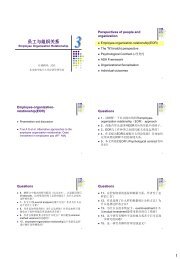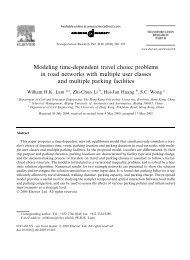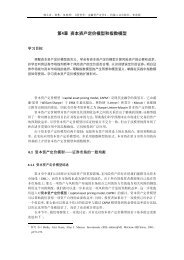Subsidiary versus Parent Perspective
Other Factors to Consider
Other Factors to Consider
- No tags were found...
You also want an ePaper? Increase the reach of your titles
YUMPU automatically turns print PDFs into web optimized ePapers that Google loves.
<strong>Subsidiary</strong> <strong>versus</strong> <strong>Parent</strong> <strong>Perspective</strong>1. Tax Differentials: different tax rates may make a projectfeasible from a subsidiary’s perspective, but not from aparent’s perspective.2. Restrictions on Remitted Earnings: governments mayplace restrictions on whether earnings must remain incountry.3. Excessive Remittances: if the parent company charges feesto the subsidiary, then a project may appear favorable from aparent perspective, but not from a subsidiary’s perspective.4. Exchange Rate Movements: earnings converted to thecurrency of the parent company will be affected by exchangerate movements.© 2012 Cengage Learning. All Rights Reserved. May not be copied, scanned, or duplicated, in whole or in part, except for use aspermitted in a license distributed with a certain product or service or otherwise on a password-protected website for classroom use.
Exhibit 14.1 Process of Remitting <strong>Subsidiary</strong> Earnings to<strong>Parent</strong>4© 2012 Cengage Learning. All Rights Reserved. May not be copied, scanned, or duplicated, in whole or in part, except for use aspermitted in a license distributed with a certain product or service or otherwise on a password-protected website for classroom use.
<strong>Subsidiary</strong> <strong>versus</strong> <strong>Parent</strong> <strong>Perspective</strong>1. The parent’s perspective is appropriate whenevaluating a project since the parent’s shareholdersare the owners and any project should generatesufficient cash flows to the parent to enhanceshareholder wealth.2. One exception is when the foreign subsidiary is notwholly owned by the parent and the foreign projectis partially financed with retained earnings of theparent and of the subsidiary.© 2012 Cengage Learning. All Rights Reserved. May not be copied, scanned, or duplicated, in whole or in part, except for use aspermitted in a license distributed with a certain product or service or otherwise on a password-protected website for classroom use.
Input for Multinational Capital BudgetingAn MNC will normally require forecasts of thefinancial characteristics that influence the initialinvestment or cash flows of the project.1.Initial investment - Funds initially invested includewhatever is necessary to start the project and additionalfunds, such as working capital, to support the projectover time.2.Price and consumer demand – Future demand isusually influenced by economic conditions, which areuncertain.© 2012 Cengage Learning. All Rights Reserved. May not be copied, scanned, or duplicated, in whole or in part, except for use aspermitted in a license distributed with a certain product or service or otherwise on a password-protected website for classroom use.
Input for Multinational Capital Budgeting (Cont.)3. Costs - Variable-cost forecasts can be developedfrom comparative costs of the components. Fixedcosts can be estimated without an estimate ofconsumer demand.4. Tax laws – International tax effects must bedetermined on any proposed foreign projects.5. Remitted funds – The MNC policy for remittingfunds to the parent influences estimated cash flows.© 2012 Cengage Learning. All Rights Reserved. May not be copied, scanned, or duplicated, in whole or in part, except for use aspermitted in a license distributed with a certain product or service or otherwise on a password-protected website for classroom use.
Input for Multinational Capital Budgeting (Cont.)6. Exchange rates - These movements are often verydifficult to forecast.7. Salvage (liquidation) values - Depends on severalfactors, including the success of the project and theattitude of the host government toward the project.8. Required rate of return - The MNC should firstestimate its cost of capital, and then it can derive itsrequired rate of return on a project based on the riskof that project.© 2012 Cengage Learning. All Rights Reserved. May not be copied, scanned, or duplicated, in whole or in part, except for use aspermitted in a license distributed with a certain product or service or otherwise on a password-protected website for classroom use.
MULTINATIONAL CAPITAL BUDGETING EXAMPLEBackground•Spartan, Inc., is considering the development of a subsidiary inSingapore that would manufacture and sell tennis rackets locally.•Spartan’s financial managers have asked the manufacturing,marketing, and financial departments to provide them withrelevant input so they can apply a capital budgeting analysis tothis project.•In addition, some Spartan executives have met with governmentofficials in Singapore to discuss the proposed subsidiary.•The project would end in 4 years. All relevant informationfollows.© 2012 Cengage Learning. All Rights Reserved. May not be copied, scanned, or duplicated, in whole or in part, except for use aspermitted in a license distributed with a certain product or service or otherwise on a password-protected website for classroom use.
MULTINATIONAL CAPITAL BUDGETING EXAMPLE• Initial investment: S$ 20 million (S$ = Singapore dollars)• Price and consumer demand:Year 1 and 2: 60,000 units @ S$350/unitYear 3: 100,000 units @ S$360/unitYear 4: 100,000 units @ S$380/unit• CostsVariable costs: Years 1 & 2 S$200/unit, Year 3 S$250/unit, Year 4 S$260/unitFixed costs: S$2 million per year• Tax laws: 20 percent income tax• Remitted funds: 10 percent withholding tax on remitted funds• Exchange rates: Spot exchange rate of $0.50 for Singapore dollar• Salvage values: S$12 million• Required rate of return: 15 percent© 2012 Cengage Learning. All Rights Reserved. May not be copied, scanned, or duplicated, in whole or in part, except for use aspermitted in a license distributed with a certain product or service or otherwise on a password-protected website for classroom use.
MULTINATIONAL CAPITAL BUDGETING EXAMPLEAnalysis•The capital budgeting analysis is conducted from theparent’s perspective, based on the assumption that thesubsidiary would be wholly owned by the parent andcreated to enhance the value of the parent.•The capital budgeting analysis to determine whetherSpartan, Inc., should establish the subsidiary isprovided in Exhibit 14.2.© 2012 Cengage Learning. All Rights Reserved. May not be copied, scanned, or duplicated, in whole or in part, except for use aspermitted in a license distributed with a certain product or service or otherwise on a password-protected website for classroom use.
Exhibit 14.2 Capital Budgeting Analysis: Spartan, Inc.12© 2012 Cengage Learning. All Rights Reserved. May not be copied, scanned, or duplicated, in whole or in part, except for use aspermitted in a license distributed with a certain product or service or otherwise on a password-protected website for classroom use.
MULTINATIONAL CAPITAL BUDGETING EXAMPLECalculation of NPVNPV= −IO+ ∑CFnt+tt=1 (1 + k)(1 +SVnk)nWhere:IO = initial outlay (investment)CF t= cash flow in period tSV n= salvage valuek = required rate of return on the projectn = lifetime of the project (number of periods)© 2012 Cengage Learning. All Rights Reserved. May not be copied, scanned, or duplicated, in whole or in part, except for use aspermitted in a license distributed with a certain product or service or otherwise on a password-protected website for classroom use.
MULTINATIONAL CAPITAL BUDGETING EXAMPLESpartan, Inc. NPV = $2,229,867Results•Because the NPV is positive, Spartan, Inc., mayaccept this project if the discount rate of 15 percenthas fully accounted for the project’s risk.•If the analysis has not yet accounted for risk,however, Spartan may decide to reject the project.© 2012 Cengage Learning. All Rights Reserved. May not be copied, scanned, or duplicated, in whole or in part, except for use aspermitted in a license distributed with a certain product or service or otherwise on a password-protected website for classroom use.
Other Factors to Consider• Exchange rate fluctuations• Inflation• Financing arrangement• Blocked funds• Uncertain salvage value• Impact of project on prevailing cash flows• Host government incentives• Real options15© 2012 Cengage Learning. All Rights Reserved. May not be copied, scanned, or duplicated, in whole or in part, except for use aspermitted in a license distributed with a certain product or service or otherwise on a password-protected website for classroom use.
Other Factors to ConsiderExchange Rate Fluctuations•Though exchange rates are difficult to forecast, amultinational capital budgeting analysis could incorporateother scenarios for exchange rate movements, such as apessimistic scenario and an optimistic scenario.•Exchange Rates Tied to <strong>Parent</strong> Currency - Some MNCsconsider projects in countries where the local currency is tiedto the dollar.•Hedged Exchange Rates - Some MNCs may hedge theexpected cash flows of a new project, so they shouldevaluate the project based on hedged exchange rates16© 2012 Cengage Learning. All Rights Reserved. May not be copied, scanned, or duplicated, in whole or in part, except for use aspermitted in a license distributed with a certain product or service or otherwise on a password-protected website for classroom use.
Exhibit 14.3 Analysis Using Different Exchange RateScenarios: Spartan, Inc.17© 2012 Cengage Learning. All Rights Reserved. May not be copied, scanned, or duplicated, in whole or in part, except for use aspermitted in a license distributed with a certain product or service or otherwise on a password-protected website for classroom use.
Exhibit 14.4 Sensitivity of the Project’s NPV to DifferentExchange Rate Scenarios: Spartan, Inc.18© 2012 Cengage Learning. All Rights Reserved. May not be copied, scanned, or duplicated, in whole or in part, except for use aspermitted in a license distributed with a certain product or service or otherwise on a password-protected website for classroom use.
Exhibit 14.5 Analysis When a Portion of the ExpectedCash Flows Are Hedged: Spartan Inc.19© 2012 Cengage Learning. All Rights Reserved. May not be copied, scanned, or duplicated, in whole or in part, except for use aspermitted in a license distributed with a certain product or service or otherwise on a password-protected website for classroom use.
Other Factors to ConsiderInflation1.Should affect both costs and revenues.2.Exchange rates of highly inflated countries tendto weaken over time.3.The joint impact of inflation and exchange ratefluctuations may be partially offsetting effectfrom the viewpoint of the parent.© 2012 Cengage Learning. All Rights Reserved. May not be copied, scanned, or duplicated, in whole or in part, except for use aspermitted in a license distributed with a certain product or service or otherwise on a password-protected website for classroom use.
Other Factors to ConsiderFinancing ArrangementMany foreign projects are partially financed by foreignsubsidiaries.1.<strong>Subsidiary</strong> financing2.<strong>Parent</strong> company financing3.Financing with other subsidiaries’ retained earnings© 2012 Cengage Learning. All Rights Reserved. May not be copied, scanned, or duplicated, in whole or in part, except for use aspermitted in a license distributed with a certain product or service or otherwise on a password-protected website for classroom use.
Other Factors to ConsiderFinancing Arrangement – <strong>Subsidiary</strong> FinancingAssume, subsidiary borrows S$10 million to purchase the previously leasedoffices. <strong>Subsidiary</strong> will make interest payments on this loan (of S$1 million)annually and will pay the principal (S$10 million) at the end of Year 4, attermination. Singapore government permits a maximum of S$2 million peryear in depreciation for this project, the subsidiary’s depreciation rate willremain unchanged. Assume the offices are expected to be sold for S$10million after taxes at the end of Year 4.1.The annual cash outflows for the subsidiary are still the same.2.The subsidiary must pay the S$10 million in loan principal at the end of 4years. However, since it receives S$10 million from the sale of the offices, itcan use the proceeds of the sale to pay the loan principal.© 2012 Cengage Learning. All Rights Reserved. May not be copied, scanned, or duplicated, in whole or in part, except for use aspermitted in a license distributed with a certain product or service or otherwise on a password-protected website for classroom use.
Other Factors to ConsiderFinancing Arrangement – <strong>Parent</strong> Company FinancingInstead of the subsidiary leasing or purchasing with borrowedfunds, the parent uses its own funds to purchase the offices.Thus, its initial investment is $15 million, composed of theoriginal $10 million investment, plus an additional $5 million toobtain an extra S$10 million to purchase the offices.1.The subsidiary will not have any loan or lease payments.2.The parent’s initial investment is $15 million instead of $10million.3.The salvage value to be received by the parent is S$22 millioninstead of S$12 million because the offices are assumed to besold for S$10 million after taxes at the end of Year 4.© 2012 Cengage Learning. All Rights Reserved. May not be copied, scanned, or duplicated, in whole or in part, except for use aspermitted in a license distributed with a certain product or service or otherwise on a password-protected website for classroom use.
Exhibit 14.6 Analysis with an Alternative FinancingArrangement: Spartan, Inc.24© 2012 Cengage Learning. All Rights Reserved. May not be copied, scanned, or duplicated, in whole or in part, except for use aspermitted in a license distributed with a certain product or service or otherwise on a password-protected website for classroom use.
Other Factors to ConsiderBlocked Funds•In some cases, the host country may block funds thatthe subsidiary attempts to send to the parent.•Some countries require that earnings generated bythe subsidiary be reinvested locally for at least 3 yearsbefore they can be remitted.© 2012 Cengage Learning. All Rights Reserved. May not be copied, scanned, or duplicated, in whole or in part, except for use aspermitted in a license distributed with a certain product or service or otherwise on a password-protected website for classroom use.
Exhibit 14.7 Capital Budgeting with Blocked Funds:Spartan, Inc.26© 2012 Cengage Learning. All Rights Reserved. May not be copied, scanned, or duplicated, in whole or in part, except for use aspermitted in a license distributed with a certain product or service or otherwise on a password-protected website for classroom use.
Other Factors to ConsiderUncertain Salvage ValueThe salvage value of an MNC’s project typically has asignificant impact on the project’s NPV.1.Consider scenario analysis to estimate NPV at varioussalvage values.2.Consider estimating break-even salvage value at zero NPV.Breakeven Salvage Value:⎡ CF= ⎢ ∑⎣ (1 + k)tnSVnIO − (1 + k)t⎤⎥⎦© 2012 Cengage Learning. All Rights Reserved. May not be copied, scanned, or duplicated, in whole or in part, except for use aspermitted in a license distributed with a certain product or service or otherwise on a password-protected website for classroom use.
Other Factors to ConsiderImpact of Project on Prevailing Cash Flows1. Impact can be favorable if sales volume ofparent increases following establishment ofproject.2. Impact can be unfavorable if existing cashflows decline following establishment ofproject.© 2012 Cengage Learning. All Rights Reserved. May not be copied, scanned, or duplicated, in whole or in part, except for use aspermitted in a license distributed with a certain product or service or otherwise on a password-protected website for classroom use.
Exhibit 14.8 Capital Budgeting When Prevailing CashFlows Are Affected: Spartan, Inc.29© 2012 Cengage Learning. All Rights Reserved. May not be copied, scanned, or duplicated, in whole or in part, except for use aspermitted in a license distributed with a certain product or service or otherwise on a password-protected website for classroom use.
Other Factors to ConsiderHost Government Incentives may include:1. Low-rate host government loans2. Reduced tax rates for subsidiary3. Government subsidies of initial investment© 2012 Cengage Learning. All Rights Reserved. May not be copied, scanned, or duplicated, in whole or in part, except for use aspermitted in a license distributed with a certain product or service or otherwise on a password-protected website for classroom use.
Other Factors to ConsiderReal Options1. Opportunity to obtain or eliminate real assets2. Value is influenced by:a. Probability that real option will be exercisedb. NPV that will result from exercising the realoption© 2012 Cengage Learning. All Rights Reserved. May not be copied, scanned, or duplicated, in whole or in part, except for use aspermitted in a license distributed with a certain product or service or otherwise on a password-protected website for classroom use.
Adjusting Project Assessment for Risk1. Risk-adjusted discount rate - The greater theuncertainty about a project’s forecasted cash flows, thelarger should be the discount rate applied to cash flows.2. Sensitivity analysis - can be more useful than simplepoint estimates because it reassesses the project based onvarious circumstances that may occur.3. Simulation - can be used for a variety of tasks, includingthe generation of a probability distribution for NPV basedon a range of possible values for one or more inputvariables. Simulation is typically performed with the aidof a computer package.© 2012 Cengage Learning. All Rights Reserved. May not be copied, scanned, or duplicated, in whole or in part, except for use aspermitted in a license distributed with a certain product or service or otherwise on a password-protected website for classroom use.
SUMMARY (Cont.)• Multinational capital budgeting requires any input that willhelp estimate the initial outlay, periodic cash flows, salvagevalue, and required rate of return on the project. With thesefactors, the international project’s net present value can beestimated, just as if it were a domestic project. However, it isnormally more difficult to estimate these factors for aninternational project. Exchange rates create an additionalsource of uncertainty because they affect the cash flowsultimately received by the parent as a result of the project.Other international conditions that can influence the cash flowsultimately received by the parent include the financingarrangement (parent <strong>versus</strong> subsidiary financing of the project),blocked funds by the host government, and host governmentincentives.© 2012 Cengage Learning. All Rights Reserved. May not be copied, scanned, or duplicated, in whole or in part, except for use aspermitted in a license distributed with a certain product or service or otherwise on a password-protected website for classroom use.

















